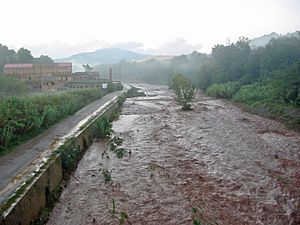Ripoll (river) facts for kids
Quick facts for kids Ripoll |
|
|---|---|

The Ripoll in Les Arenes, Castellar del Vallès.
|
|
| Country | Spain |
| Region | Catalonia |
| Cities | Sant Llorenç Savall, Castellar del Vallès, Sabadell, Barberà del Vallès, Ripollet, Montcada i Reixac |
| Physical characteristics | |
| Main source | Serra de Granera Granera, Catalonia, Spain 640 m (2,100 ft) |
| Length | 39.5 km (24.5 mi) |
The Ripoll is a river located in Catalonia, Spain. It flows through a region called comarca of Vallès Occidental. The river crosses this area from north to south. It eventually joins another river, the Besòs, which is close to the city of Barcelona.
Contents
About the Ripoll River's Path
The Ripoll river starts in the Serra de Granera mountains. Its source is about 640 meters (2,100 feet) above sea level. The river then flows downhill and ends in Montcada i Reixac. Here, it is about 35.5 meters (116 feet) above sea level.
The main part of the river is about 39.5 kilometers (24.5 miles) long. If you add all its smaller streams and branches, the total length is about 181.5 kilometers (112.8 miles).
Cities Along the River
The Ripoll river flows through many towns and cities. These include:
As the river moves through the region, it cuts deep paths into the ground. This is because the soil is made of soft clay that wears away easily.
How the Ripoll River Was Used Over Time
For a very long time, people living near the Ripoll river used its water. They used it to water their farms and power their mills.
Early Uses: Farms and Flour Mills
People have been using the river for irrigation since at least the mid-10th century. Priests from Sant Llorenç Savall built a system to bring water to farms. This system helped grow crops along the riverbanks. The river also powered mills that ground grain into flour.
From Paper to Textiles
Later, many of these mills changed. They started making paper instead of flour. But by the 18th century, paper making was not as important.
In the 19th century, the mills changed again. They became textile factories. These factories made fabrics and clothes. They used the river's water until the late 20th century. Sadly, the dyes and chemicals from these factories made the river water very dirty.
Cleaning Up the River
More recently, many textile factories closed down. This happened because the textile industry in Catalonia faced problems. When the factories closed, less pollution went into the river.
Now, people are working to make the Ripoll river clean again. They want to restore the river so that local communities can enjoy it. The river had become dirty not only from factory pollution but also from other issues. Efforts are being made to bring the river back to a healthy state for everyone.
The 1962 Flood Disaster
In 1962, the Vallès Occidental region experienced very bad floods. Strong winds also hit the area. This natural disaster caused a lot of damage and led to many deaths. The people living closest to the river were affected the most.
See also
- List of rivers of Catalonia
- In Spanish: Río Ripoll para niños


